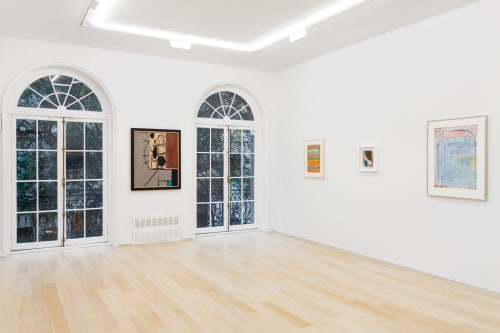Color(less)
-
Overview
Diebenkorn, Goldberg, Gorky, Held, Judd, Kline, LeWitt, Mangold, Motherwell, Rockburne, Sterne, Tobey
Van Doren Waxter is pleased to present Color(less), a selection of 14 works on paper by Richard Diebenkorn, Michael Goldberg, Arshile Gorky, Al Held, Donald Judd, Franz Kline, Sol Lewitt, Robert Mangold, Robert Motherwell, Dorothea Rockburne, Mark Tobey and Hedda Sterne. Color(less) offers a vantage point for considering the formal qualities of line and color within two of the defining movements in 20th century art: 1950s and 60s Abstract Expressionism and 1970s Minimalism. The striking contrast between the evocative Abstract Expressionists, who sought to convey a personal quality of emotion through spontaneous mark making, and the restrained Minimalists, who were often interpreted as reacting to Abstract Expressionism, offers a rare opportunity to view one of art history’s most powerful binaries. The exhibition will be on view October 28th through December 23rd, 2015 at 23 E. 73rd St. Franz Kline’s Untitled (1954) exemplifies the Ab Ex artist’s spontaneity and singular voice in bold, primary-colored hues, punctuated by strategic brushwork in signature black paint. The linear quality and employment of negative and positive space that defined so many of his masterpieces, and set him apart from the all-over compositional structure of many of his peers, is entirely evident in this piece, which impacts visual space well beyond its 23 by 18-inch format. Mark Tobey’s Living wall with a sign (1965) offers a similarly distinctive technique of the artist’s: an intricate composition of thousands of small, interwoven brushstrokes. The use of primarily black and white tempera emphasizes the mark making of the artist, which was influenced by his exploration of Chinese calligraphy and theories of Brownian motion. Together with pieces by Michael Goldberg and Arshile Gorky, these works make up the earlier period in the show and offer a heterogeneous view of the Abstract Expressionist style. At the other end of the spectrum, are six pencil and charcoal on paper pieces, such as Dorothea Rockburne’s Drawing Which Makes Itself (RP #3) (1973) from her groundbreaking series that examined the metaphysical properties of paper. Interested in the inherent qualities of paper itself, Rockburne employed careful, geometric folding in addition to drawing in charcoal, to render the forms captured not only on, but in the paper itself. The architectural quality of the folds in Rockburne’s pieces are easily at home with doyens of the Minimalist style, Donald Judd and Sol LeWitt, who are represented in three pieces that employ very few, precise pencil lines. Both of LeWitt’s A Red Line of Random Length, Drawn from the Left Side of the Page and A Line, Not Straight, Drawn from the Center of the Page to the Lower Left Corner (1974), in particular, epitomize the “less is more” credo of the Minimalist investigation into the physical world and the ability of art to articulate its parameters. There are, of course, outliers in any group, which Color(less) pays homage to as well. An Untitled (1979) piece from Diebenkorn’s Ocean Park series, straddles the divide between tight, geometric linework and autonomous, colorful painting produced during a period when the artist began to restructure the figuration that had defined the work of his prior period. A Hedda Sterne oil pastel, Horoizon Study (1966) provides the most representational touchstone in the show in vivid, sunset tones stacked in the Color Field manner, reaching the core of the tension between the groups–the need for art to reflect a unifying vision of the world, or how such a vision might be illustrated and the potential for color and line to achieve this.
-
Installation Shots
-
Artist





